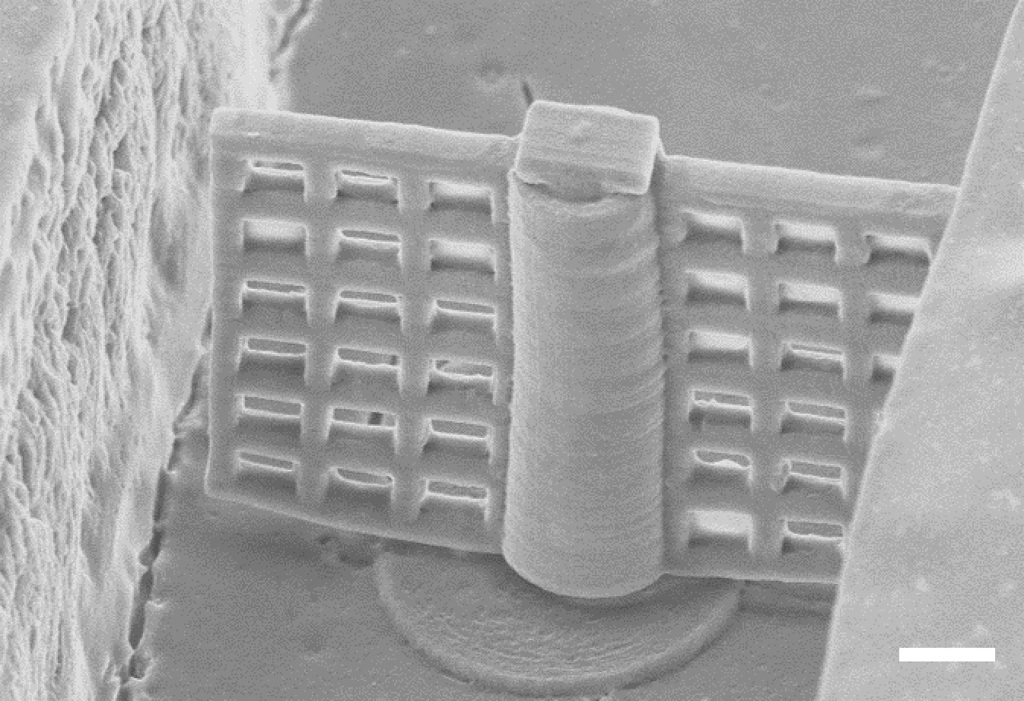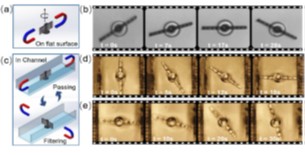About
15 June 2021
Researchers 3D Print Rotating Microfilter for Lab-on-a-Chip Applications
With filter modes that can be switched via a magnetic field, device shows promise for cell sorting
WASHINGTON — Researchers have fabricated a magnetically driven rotary microfilter that can be used to filter particles inside a microfluidic device. They made the tiny turning filter by creating a magnetic material that could be used with a very precise 3D printing technique known as two-photon polymerization.
Microfluidic devices, also known as lab-on-a-chip devices, can be used to perform multiple laboratory functions inside a chip that usually measures a few square centimeters or less. These devices contain intricate networks of microfluidic channels and are becoming more and more complex. They may be useful for a variety of applications such as screening molecules for therapeutic potential or performing blood tests that detect disease.

Caption: Researchers fabricated tiny magnetically driven rotating filters for use in microfluidic channels. The filters are just 70 microns wide and 60 microns tall with square openings that measure 6.5 microns on each side. Scale bar: 10 microns
Credit: Dong Wu, University of Science and Technology of China
“By changing the direction of external magnetic field, the microfilter we made can be remotely manipulated on demand to either filter certain-sized particles or to allow them all to pass,” said Dong Wu, a member of the research team from the University of Science and Technology of China. “This functionality could be used for many types of chemical and biological studies performed in lab-on-a-chip devices and, importantly, makes it possible for the chips to be reused.”
In The Optical Society (OSA) journal Optics Letters, Wu together with colleagues from the Hefei University of Technology and RIKEN Center for Advanced Photonics in Japan show that their new rotary microfilter filters can sort particles in a microfluidic device with high performance.
“This filter could eventually be used to sort cells of different sizes for applications such as isolating circulating tumor cells for analysis or detecting abnormally large cells that may indicate disease,” said Chaowei Wang from University of Science and Technology of China. “With further development it might even be possible to use it in devices placed inside the body for cancer detection.”
A more versatile filter
Filters with micrometer-sized holes are often used in microfluidic chips as a passive way to sort particles or cells based on sizes of the holes. However, because the number and shape of holes in the filter cannot be dynamically changed, available devices lack the flexibility to sort different types of particles or cells on demand. To expand the usefulness of microfluidic devices, the researchers developed a filter that can freely switch between modes such as selective filtering and passing.
They created the new filter using two-photon polymerization, which uses a focused femtosecond laser beam to solidify, or polymerize, a liquid light-sensitive material known as photoresist. Thanks to two-photon absorption, the polymerization can be done in a very precise manner, enabling fabrication of complex structures on the micron scale.
To make the microfilter, the researchers synthesized magnetic nanoparticles and mixed them with the photoresist. Fabricating the rotary microfilter required them to optimize the laser power density, number of pulses and scanning intervals used for polymerization. After testing its magnetically driven properties on a glass slide, they integrated the microfilter into a microfluidic device.

Caption: A schematic diagram of the magnetic rotary microfilter on a flat surface is shown in (a). The rotary microfilter is magnetically turned in a liquid environment on the flat surface by applying a uniform magnetic field with different orientations (b). A schematic diagram of manipulating magnetically rotary microfilter in channel is shown in (c) and demonstrated in an alcohol solution (d).
Credit: Dong Wu, University of Science and Technology of China
Multiple filtering modes
To filter larger particles, a magnetic field perpendicular to the microchannel is applied. After the filtering process is complete, the large particles can be released by applying a magnetic field that is parallel to the microchannel, which will rotate the microfilter by 90°. The filtering process can then be repeated as needed.
The researchers verified the filtering performance of the filter using polystyrene particles with diameters of 8.0 and 2.5 microns that were mixed in an alcohol solution. “It was clear that particles smaller than the pore size easily passed through microfilter while bigger ones were filtered out,” said Chenchu Zhang from University of Science and Technology of China. “When in passing mode, any larger particles captured by the filter were washed away with the fluid, which prevents filter clogging and allows reuse of the microfilter.”
The researchers plan to optimize the microfilter so that it can be used to separate cells by size. If successful, the researchers say this technology could eventually be adapted for applications in the body. Because body fluid has a higher viscosity than alcohol, they will need to design the structure or treat the surface of the microchannel to maintain a high flow rate and to prevent cells from adhering to the channels or filter.
Paper: C. Wang, Z. Hu, L. Yang, C. Zhang, L. Zhang, S. Ji, L. Xu, J. Li, Y. Hu, D. Wu, J. Chu, K. Sugioka, “Magnetically driven rotary microfilter fabricated by two-photon polymerization for multimode filtering of particles,” Opt. Lett., 46, 12, 2968-2971 (2021).
DOI: https://doi.org/10.1364/OL.428751.
About Optica Publishing Group
Optica Publishing Group is a division of the society, Optica, Advancing Optics and Photonics Worldwide. It publishes the largest collection of peer-reviewed and most-cited content in optics and photonics, including 18 prestigious journals, the society’s flagship member magazine, and papers and videos from more than 835 conferences. With over 400,000 journal articles, conference papers and videos to search, discover and access, our publications portfolio represents the full range of research in the field from around the globe.
About Optics Letters
Optics Letters has been publishing high-impact research in the field of photonics for over 45 years and offers rapid dissemination of new results in all areas of optical science with short, original, peer-reviewed communications. Optics Letters accepts papers that are noteworthy to a substantial part of the optics community. Published by Optica Publishing Group and led by Editor-in-Chief Miguel Alonso, Institut Fresnel, École Centrale de Marseille and Aix-Marseille Université, France, University of Rochester, USA. For more information, visit Optics Letters.
About The Optical Society
The Optical Society (OSA) is dedicated to promoting the generation, application, archiving, and dissemination of knowledge in optics and photonics worldwide. Founded in 1916, it is the leading organization for scientists, engineers, business professionals, students, and others interested in the science of light. OSA’s renowned publications, meetings, online resources, and in-person activities fuel discoveries, shape real-life applications and accelerate scientific, technical, and educational achievement.
About Optics Letters
Optics Letters has been publishing high-impact research in the field of photonics for over 45 years and offers rapid dissemination of new results in all areas of optical science with short, original, peer-reviewed communications. Optics Letters accepts papers that are noteworthy to a substantial part of the optics community. Published by Optica Publishing Group and led by Editor-in-Chief Miguel Alonso, Institut Fresnel, École Centrale de Marseille and Aix-Marseille Université, France, University of Rochester, USA. For more information, visit Optics Letters.
Media Contact
